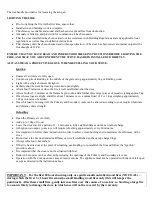
Saltfire ST-X4
INSTALLATION AND OPERATING INSTRUCTIONS
INTRODUCTION
SAFETY
Safety is the most important consideration when using and installing your stove. If not installed and used correctly, a house
fire could result. Installation must comply with relevant national and local Building Regulations and fire safety standards.
IN THE EVENT OF CHIMNEY FIRE, EVACUATE THE PROPERTY AND CALL THE EMERGENCY SERVICES.
Your stove will be heavy and care needs to be taken when lifting - 2 people will normally be required to lift.
UNPACKING
Your stove will have several of its components stored inside the stove itself for transportation.
Do NOT drag the stove on its legs – it must be carefully lifted into place.
Inside you will find a glove which must be used when opening the door or when adjusting air vents when the fire is hot.
INSTALLATION
Installation of your stove must comply with relevant local and national Building Regulations and fire safety standards.
TECHNICAL
Model; “
Saltfire ST-X4
”
Nominal heat output – 4.1kW
Normal range 2 - 5kW
Gross Weight of Stove (inclusive of packaging) - 72 kg.
Net Weight of Stove - 70 kg.
Max Height - 489 mm
Max Width - 395 mm
Max Depth - 330 mm
Flue Diameter - 125mm (5”)
Mean flue gas temperature directly downstream of the flue spigot - 265 degrees C. (with closed doors).
Flue gas mass flow – 3.4g/s
Mean CO emission (at 13% Oxygen) – 0.20%
Net Energy Efficiency 79.7%
The stove must not be installed within the specified minimum distances to combustible materials: A gap of at least 400mm
needs to left between the stove and any combustible materials at the sides and 500mm to the rear. Adjacent walls should be of
non-combustible materials and construction, preferably masonry or brickwork.
Your stove will require a constant air supply, and should not be used at the same time and in the same room/space as
extractor fans or any device which may draw air supply away from the stove.




























